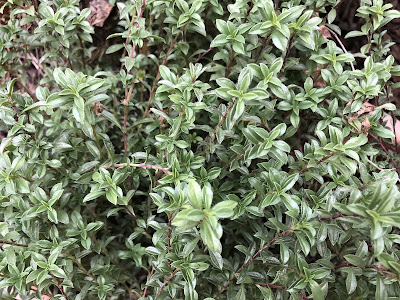
Plant garlic, artichokes, herbs and more -- when it's not raining

|
|
Winter savory does well outdoors in winter, not
surprisingly. More cold-sensitive herbs, such as
basil, can be grown in a sunny window indoors. (Photo: Kathy Morrison) |
It’s official: Winter has arrived!
This California Christmas week looks pretty chilly with lots of rain in the Valley and several feet of snow in the Sierra.
On this first day of winter, Sacramento is shivering in the 40s – but that’s balmy compared to higher elevations. Truckee’s forecast high on Christmas Day is only 27 degrees with an overnight low of just 12.
While we might not have much good “gardening weather” this week, it doesn’t mean we’re not gardening.
* Two favorite crops – onions and garlic – are traditionally planted on the first day of winter (or soon after) for summer harvest. These root vegetables both come with a bonus; their greens can be used in winter and spring.
* Also ready for planting (as soon as the ground dries out a little) are bare-root artichokes and asparagus. Both perennial vegetables do well in Sacramento and can be planted in late December or January. Because they’ll stay in the same place for years to come, make sure their new home has good drainage and plenty of organic matter such as compost worked into the soil. Ideally, choose a spot with morning sun and a little afternoon shade to avoid sunburn in summer.
* This also is the time to plant bare-root roses and fruit trees such as fig, apple, pear, peach, cherry, nectarine, plum and apricot (and all their relatives). Buy early for best selection.
* Got bulbs? Put together a quicky two-punch flower display that also makes a great gift. In a deep pot, plant tulips, daffodils or other bulbs about 6 inches deep. Cover with an inch or two of soil. Then, transplant pansies, calendulas, Iceland poppies, cyclamen or other winter bloomers on top of the bulbs. Space the transplants so they’re between the bulbs if possible. Or group all the bulbs in the center of the pot and transplant the pansies, etc., around the pot’s edge. The annuals will soon cover the top of the pot with flowers, then the bulbs will push up between them, adding some late winter thrills.
* Herb gardening is year-round. Herbs also make good living Christmas gifts for both the gardeners and cooks on your gift list. Basil and parsley can be grown indoors in winter on a sunny, warm window sill. Other good gift herbs include chives, lavender, lemon balm, marjoram, mint, oregano, rosemary, tarragon and thyme. Or give garlic with instructions on how to plant.
Comments
0 comments have been posted.Sacramento Digs Gardening to your inbox.
Sites We Like
Garden Checklist for week of July 21
Your garden needs you!
* Keep your vegetable garden watered, mulched and weeded. Water before 8 a.m. to reduce the chance of fungal infection and to conserve moisture.
* Feed vegetable plants bone meal, rock phosphate or other fertilizers high in phosphate to stimulate more blooms and fruiting. (But wait until daily high temperatures drop out of the 100s.)
* Don’t let tomatoes wilt or dry out completely. Give tomatoes a deep watering two to three times a week.
* Harvest vegetables promptly to encourage plants to produce more. Squash especially tends to grow rapidly in hot weather. Keep an eye on zucchini.
* Pinch back chrysanthemums for bushy plants and more flowers in September.
* Remove spent flowers from roses, daylilies and other bloomers as they finish flowering.
* Pinch off blooms from basil so the plant will grow more leaves.
* Cut back lavender after flowering to promote a second bloom.
* It's not too late to add a splash of color. Plant petunias, snapdragons, zinnias and marigolds.
* From seed, plant corn, pumpkins, radishes, winter squash and sunflowers.